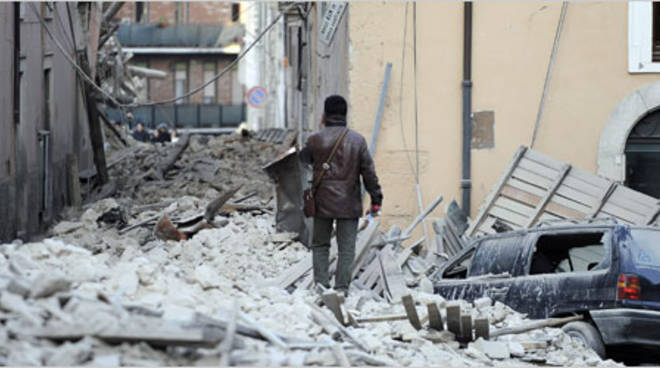At Least 92 Die in Earthquake in Italy
Più informazioni su

The first news of New York Times. More than 90 people died and tens of thousands were left homeless when an earthquake with a magnitude of 6.3 shook central Italy early Monday morning, seriously damaging buildings in the mountainous Abruzzo Region east of Rome, officials said. The Italian news agency, ANSA, quoted rescue workers in mid-afternoon as saying the death toll had reached 92. A spokesman for Italy’s Civil Protection Agency said on national television that an estimated 40,000 to 50,000 people had been left homeless. (No earthquake in Amalfi and Sorrento Coast in Campania but is next in Abruzzo) The epicenter was in L’Aquila, a picturesque Medieval fortress hill town, where most of the deaths occurred, officials said. Aftershocks shuddered through the area, hampering rescue efforts as people clawed through the debris by hand, frantically seeking survivors. In the town’s historic main square, the cupola of the 18th-century Santa Maria del Sofraggio church was broken in half like an eggshell, revealing the stucco patterns inside the dome. Other historic buildings were also damaged. Italian authorities assisted elderly residents in leaving the square, where they had fled in search of safety after the main quake. The narrow streets of the historic center were filled with rubble, and parked cars sat crushed under large blocks of debris. Outside a local convent, a dozen nuns still dressed in their bright orange and blue bathrobes climbed into a van headed to an assistance center. The convent was damaged, and Sister Lidia, the mother superior, said a 82-year old nun had died of shock. “The quake, it was very strong,” she said. “Some towns in the area have been virtually destroyed in their entirety,” Gianfranco Fini, speaker of the lower house of Parliament, said in Rome before the chamber observed a moment of silence. President Obama, visiting Turkey on an eight-day overseas tour, offered his condolences to Italian families hit by the quake. The situation is “extremely critical, as many buildings have collapsed,” Luca Spoletini, a spokesman for the civil protection agency, told ANSA shortly after the quake struck. Prime Minister Silvio Berlusconi canceled a trip to Moscow and declared a state of emergency in the region. Reports from the areas said that at least 26 towns had been affected by the earthquake. Four children died in the hospital after their house collapsed, ANSA reported. A fifth child died in the village of Fossa, eight miles from L’Aquila, a town of 80,000. The quake struck around 3:30 a.m. and could be felt as far away as Rome, some 60 miles to the west, where it rattled furniture and set off car alarms. The United States Geological Survey said the earthquake that hit L’Aquila had a magnitude of 6.3, the most violent of several quakes to hit the region overnight. Part of a student dormitory in L’Aquila had collapsed, and initial reports said one person died and seven people may be missing in the debris. At midday, shaken students sat outside the rubble of the four-story dormitory, expressing fears for the fate of others who may not have survived. “We’re waiting for my son,” said a distraught-looking mother who declined to give her name. She stood among a knot of anxious onlookers and hid her red eyes behind large sunglasses. “This shouldn’t have happened,” said Gabriele Magrini, 21, a student of physics at L’Aquila University, who had been across town at a friend’s house when the quake struck. He said he had been waiting at the university since 4 a.m., adding: “We’ve only seen two people come out. We’re still waiting for 10.” There was a first shock after 11 p.m., Mr. Magrini said, adding that he hadn’t realized how bad the major shock had been until he saw the destruction. Damage to buildings was visible throughout the city, including at the town’s main cathedral. On Monday afternoon, the Italian Culture Ministry posted a list of historical monuments that had been damaged in l’Aquila, including the steeple of the church of San Bernardino; a small cupola in the church of Sant’Agostino; the cupola of the church of the Suffragio; a palazzo housing the state archives; part of the transept of the basilica of Santa Maria di Collemaggio; and parts of the 16th century castle that houses the National Museum of Abruzzo, which has been closed to the public. The worst hit seemed to be the city center, but the modern concrete buildings in the outer reaches of the city were also affected. Residents wheeling dusty suitcases wandered through the streets as rescue workers sifted through the rubble. Electricity, phone and gas lines were also reported damaged. Earlier, nuns from a local convent attended to hundreds of residents gathered in the central Piazza Duomo, ANSA reported. “There are many palazzi that are cracked — walls have fallen in,” Joshua Brothers, an American missionary, told CNN. “It’s a disaster never before seen,” said Franco Totani, a lawyer who said he was born in L’Aquila and was leaving the town to stay at an elderly uncle’s house in Rome. “I’ve seen earthquakes before but this is a catastrophe.” People in surrounding cities in the Abruzzo region and the neighboring Marche region also rushed into the streets, fearing their houses would collapse. In a letter to the archbishop of L’Aquila, the Vatican secretary of state, Tarcisio Bertone, wrote that Pope Benedict XVI was praying “for the victims, in particular for children.” Speaking on Rainews 24, Guido Bertolaso, Italy’s top civil protection official said that the earthquake was “comparable if not superior to the one which struck Umbria in 1997.” Offers for help have come from various European countries, while volunteers were mobilizing throughout Italy. Seismic activity is relatively common in Italy, but intensity like Monday’s quake is rare. Mr. Bertolaso likened the quake in L’Aquila to the tremors that struck the central Umbria region on Sept. 26, 1997, The Associated Press reported. That quake killed 10 people and damaged medieval buildings and churches across the region, including Assisi’s famed basilica. The last major quake to hit central Italy struck the south-central Molise region on Oct. 31, 2002, killing 28 people, including 27 children who died when their school collapsed. The L’Aquila quake was the worst to hit Italy since 1980, when a 6.9-magnitude earthquake struck Eboli, south of Naples, leaving more than 2,700 people dead. Rachel Donadio reported from L’Aquila, and Elisabetta Povoledo from Rome.




